The hybrid fixed-wing/vertical takeoff and landing (VTOL) configuration combines the designs of both fixed-wing UAVs and rotary-wing UAVs into one model. There are several designs that have been created for these types of unmanned aerial vehicles (UAVs).
Here are the two main types of hybrid fixed-wing/VTOL UAVs:
- Unmanned convertiplanes
- Tail-sitter UAVs
Take note that unmanned convertiplanes include quadplanes, tilt-rotor, and tilt-wing UAVs (more on this below).
A Quick Overview On What Hybrid Fixed-Wing/VTOL UAVs Are And How They Work
Hybrid fixed-wing/vertical takeoff and landing (VTOL) unmanned aerial vehicles (UAVs) are drones that combine both the fixed-wing UAV and rotary-wing UAV configurations into one design attempting to eliminate the drawbacks present in both individual designs.
Check out our full article on what hybrid fixed-wing/VTOL UAVs are where we dive into how they work, their types, applications, parts/components, advantages/disadvantages, and some examples:
Related Post: What Are Hybrid Fixed-Wing/VTOL Drones (UAVs)?
They use fixed wings shaped like airfoils and other parts and components found in fixed-wing UAVs (tail assembly, fuselage) for horizontal flight. Our full article on fixed-wing drones goes into more detail on how they work.
They also use rotary blades which are spun at very fast speeds by motors to capture airflow for both horizontal propulsion but more often for vertical flight.
Both fixed-wing and rotary-wing UAVs obtain lift using the same principle.
Air flows faster on the curved top side of the wing than on the flatter underside due to its shape. This causes less air pressure to accumulate on the top of the wing creating a suction that lifts the airfoil up enabling both unmanned fixed-wing and rotary-wing drones to fly.
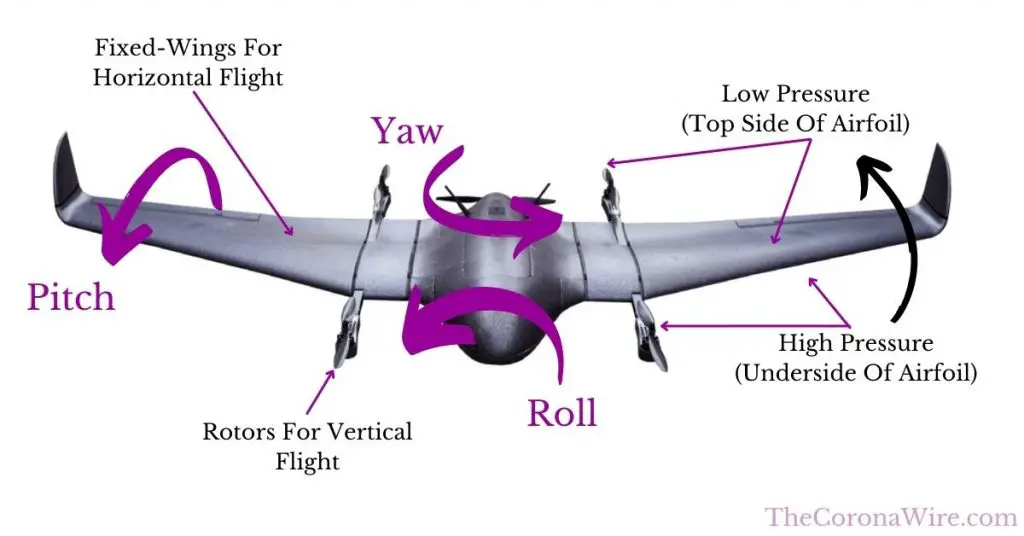
These along with an efficient and effective propulsion system including powerplants such as batteries, engines, fuel cells (FCs), solar energy etc and propulsion devices such as propellers enable hybrid fixed-wing/VTOL UAVs to function.
Check out our full post where we dive into several powerplants and propulsion devices currently used in drones. For each power source, we expand on how they work, the types, advantages/disadvantages, and real-world examples.
Related Post: How Are Drones Powered? 6 Drone Energy Sources Explained
What Are Unmanned Convertiplanes?
Unmanned convertiplanes are hybrid fixed-wing/VTOL unmanned aerial vehicles (UAVs) that transition from vertical flight for takeoff and landing to horizontal flight, either deactivating a set of rotors or angling their proprotors for forward propulsion while utilising their fixed wings.
Proprotors are propellers that are used for both vertical and horizontal flight.
Here are the three types of convertiplanes:
- Tilt-rotor UAVs
- Tilt-wing UAVs
- Quadplanes
Take note that there can be hybrids of each of these designs. For example, there can be quadplanes with tilt-rotor capabilities.
What are tilt-rotor unmanned aerial vehicles (UAVs)?
Tilt-rotor unmanned aerial vehicles (UAVs) are hybrid fixed-wing/VTOL drones that have rotors placed on the tips of fixed wings capable of rotating both vertically and horizontally during flight for vertical takeoff and landing and horizontal flight.
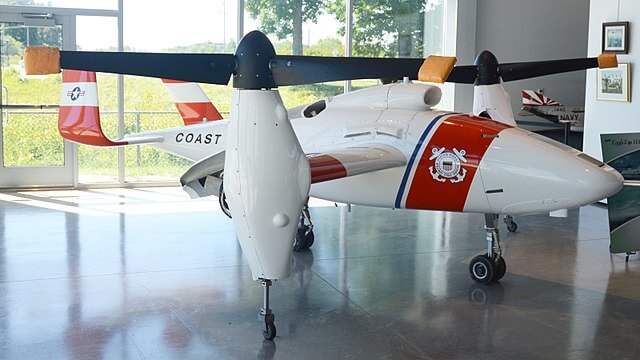
Check out our full post where we dive into what tilt-rotor UAVs are, how they work, their applications, advantages/disadvantages and examples:
Related Post: What Are Tilt-Rotor Hybrid Fixed-Wing/VTOL UAVs?
The Trinity F90+ made by Quantum Systems and the Dragonfish made by Autel Robotics are two examples of tilt-rotor UAVs.
What are tilt-wing unmanned aerial vehicles (UAVs)?
Tilt-wing unmanned aerial vehicles (UAVs) are hybrid fixed-wing/VTOL drones that have wings equipped with two or more rotors where the entire wings are capable of rotating both vertically and horizontally during flight for vertical takeoff and landing and horizontal flight.
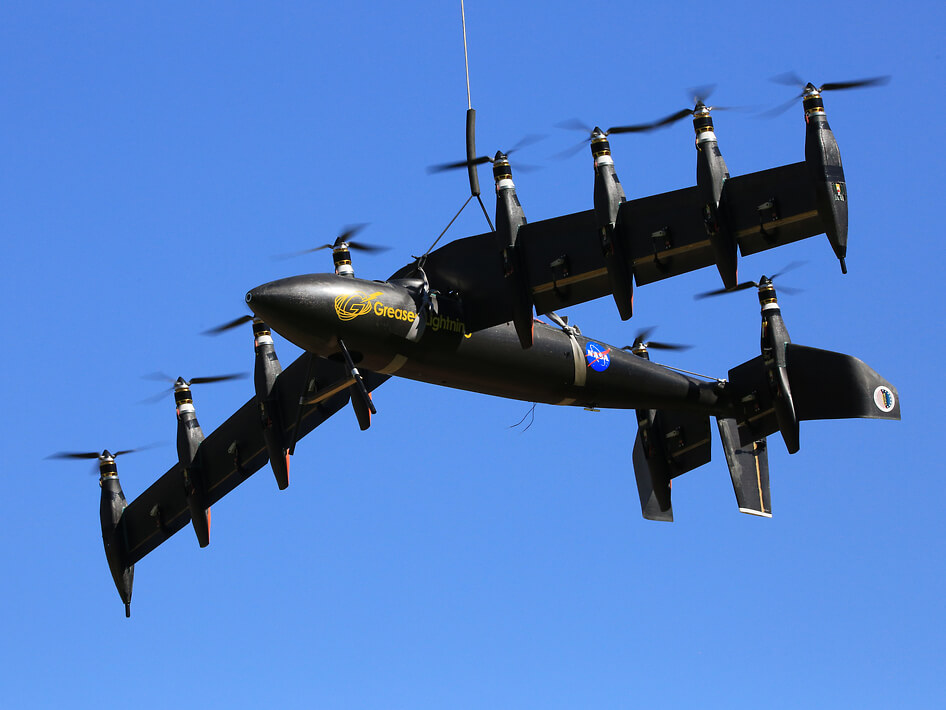
There have not yet been many commercially successful tilt-wing UAVs in production today so there are therefore not many examples to give.
Check out our full post on what tilt-wing UAVs are where we dive into how they work, their applications, parts/components, advantages/disadvantages and examples:
Related Post: What Are Tilt-Wing Hybrid Fixed-Wing/VTOL UAVs?
The (GL-10) Greased Lightning made by NASA (seen in image above) and the Koker 1 made by Saman Communication Group are two examples of tilt-wing UAVs.
What are quadplanes?
Quadplanes are hybrid fixed-wing/VTOL unmanned aerial vehicles (UAVs) that have vertical facing propellers for vertical takeoff and landing along with fixed wings and horizontal propellers for horizontal flight.
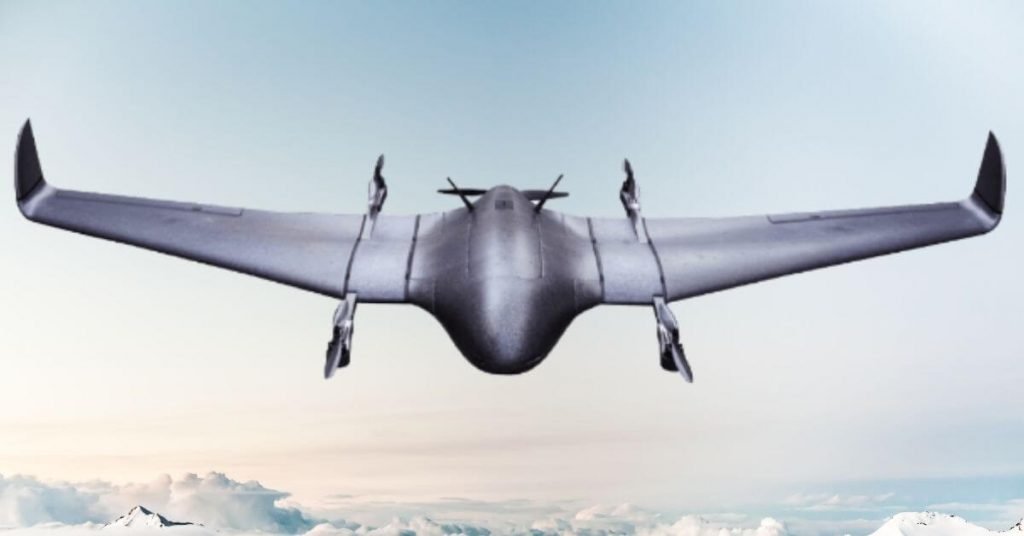
Hybrid fixed-wing/VTOL UAVs can incorporate various designs used in fixed-wing UAVs as seen above. The above drone in the image is utilising the flying wing configuration.
Check out our full post on quadplanes where we explain how they work, applications, advantages/disadvantages, and examples:
Related Post: What Are Quadplanes? Hybrid Fixed-Wing/VTOL UAVs Explained
The Heliplane made by Drone Volt and the Stalker made by Lockheed Martin and PowerLight Technologies are two examples of quadplanes.
What Are Tail-Sitter Unmanned Aerial Vehicles (UAVs)?
Tail-sitter unmanned aerial vehicles (UAVs) are hybrid fixed-wing/VTOL drones that takeoff and land on the tail of the aircraft vertically then rotate their entire body horizontally during flight.
These types of drones operate in a similar way to a missile.
Tail-sitter UAVs typically don’t have any propulsion device (propeller) that deactivates or shifts during flight.
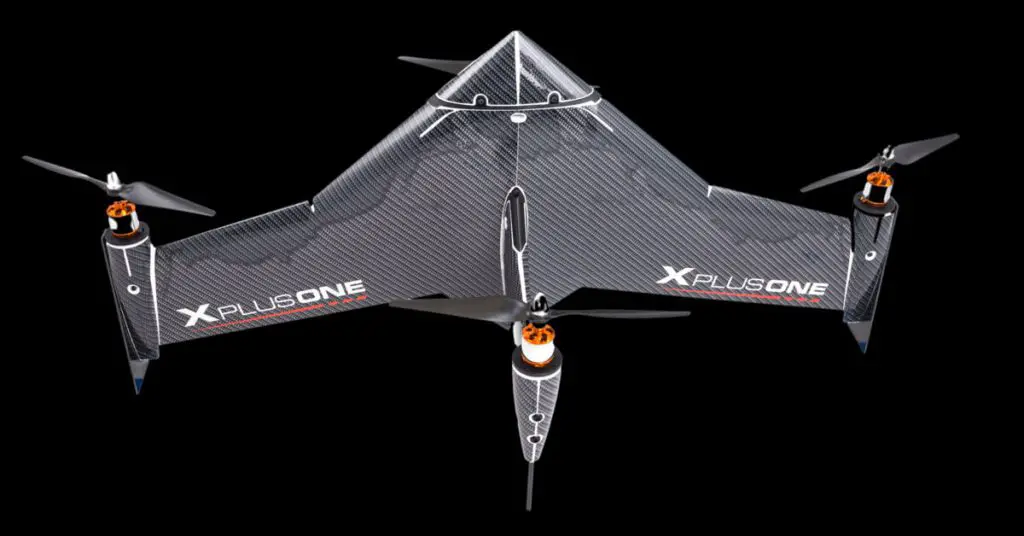
Check out our full post on what tail-sitter UAVs are where we dive into how they work, applications, advantages/disadvantages, parts/components and examples:
Related Post: What Are Tail-Sitter Hybrid Fixed-Wing/VTOL UAVs?
The SkyTote made by AeroVironment and the Swing made by Parrot are two examples of tail-sitter UAVs.
Conclusion
These types of hybrid fixed-wing/VTOL UAVs have not all yet been as successful as others but they definitely all have potential due to their many benefits and fewer drawbacks.
As time goes on manufacturers and designers will be capable of refining these designs and improving the technology to a point that really allows them to take off in popularity.
We highly recommend you check out our main article on what hybrid fixed-wing/VTOL UAVs are to learn more about these types of drones.
